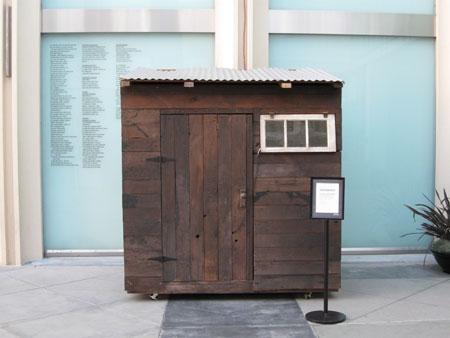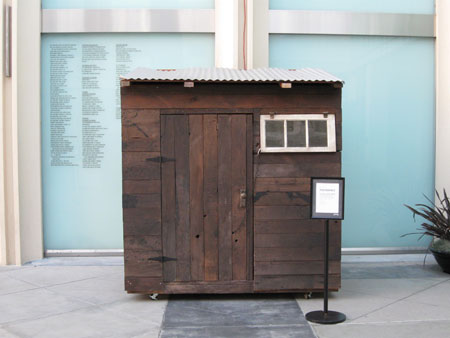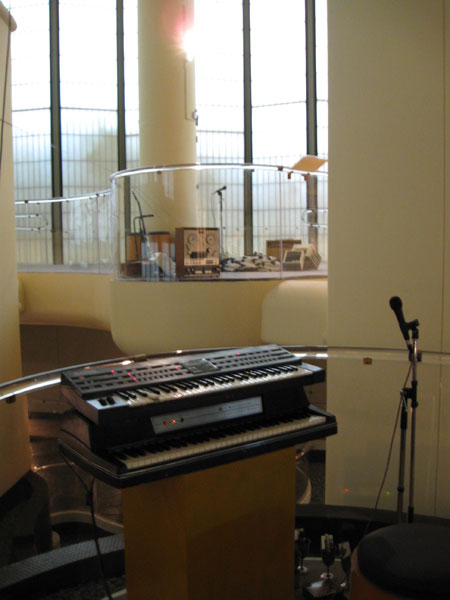Last week I was out on the plaza here at the museum when I noticed a rickety old tin-roofed shack sitting on the plaza, just across from Pentimento, the museum restaurant.
Knowing that we hadn’t lately commissioned a starchitect for a new project, I took a closer look. I couldn’t see very well inside, and the door seemed to be chained shut, but it sure sounded like someone was inside—a moaning sound reverberated from inside, looping over itself like a sonic snake eating its own tail.
Then I remembered: it was Thursday.
That meant Emily Lacy was here again, as she has been every Thursday through Sunday in December and January, doing her Temples of the Mind performance. This was the “Hermit’s Cabin” component she mentioned in the Q&A we did with her—apparently available for entry, though it didn’t seem so when I happened to be there.
The moaning cabin might have seemed a little odd to your average salad-eater at Pentimento, but I have to admit I pulled up a seat and simply sat outside the cabin for a few minutes, listening—and enjoying. (Of course, I’m a guy who was also mesmerized by the 88 Boadrum event we did a couple of years ago.) After a bit I got up and went into the Pavilion for Japanese Art, where Lacy is performing for five-hour stretches on the days she’s here.
Now here was the experience.
The Japanese Pavilion is set up in such a way that one follows a spiraling ramp from the ground floor up to the top, with small landings, or tokonomas, along the way. On each of these tokonomas was a pile of small practice amplifiers, effects pedals, and instruments. While I was there no one was actually playing any of the instruments, but the amplifiers were emanating a variety of sounds.
The first thing I picked out was that woman’s moaning—maybe Lacy was in that cabin wildin’ out, transmitting her looped and delayed voice into the pavilion, where it carried up from the ground floor to the ceiling, bouncing off the walls of Bruce Goff’s strange but wonderful building. Along with her ghostly voice, there in the pavilion I could also hear percussion and synthesized digital squiggles of sound. It was a much fuller, enveloping experience compared to loitering outside the Hermit’s Cabin.
I decided to walk the pavilion, from each little sound station to the next. Here is where the interaction of Emily Lacy’s performance with the architecture itself becomes apparent. As you walk from one tokonoma to the next, each of the different elements of sound dominate or recede in your ears. In one area the disparate sounds are cacophonous; in another, totally musical; still elsewhere it feels like more than music—it’s something more immersive than mere melody and rhythm. The way the sounds morphed depending on where I was—standing still, moving from a tokonoma to the perimeter ramp, moving from the ground floor to the very top—reminded me in some ways of a similar experience I had with LaMonte Young’s brilliant Dream House in New York, a minimalist work comprised of two gigantic speakers emanating long droning tones in an otherwise empty room swathed in pink light. As you move through that room, the frequencies of those tones start to run long or short in your ears—you in effect “conduct” the piece depending on how you move (or don’t move) through the room. Lacy’s piece wasn’t exactly the same—I felt more like I was “mixing” than “conducting”—but it was another great experience of sound and architecture coming together to make something altogether different.





